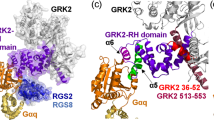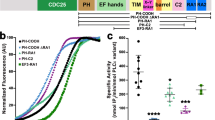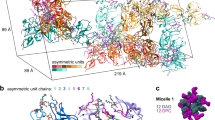Abstract
GTP-bound subunits of the Gq family of Gα subunits directly activate phospholipase C-β (PLC-β) isozymes to produce the second messengers inositol 1,4,5-trisphosphate and diacylglycerol. PLC-βs are GTPase activating proteins (GAPs) that also promote the formation of GDP-bound, inactive Gβ subunits. Both phospholipase activation by Gα–GTP subunits and GAP activity require a C-terminal region unique to PLC-β isozymes. The crystal structure of the C-terminal region from an avian PLC-β, determined at 2.4 Å resolution, reveals a novel fold composed almost entirely of three long helices forming a coiled-coil that dimerizes along its long axis in an antiparallel orientation. The dimer interface is extensive (∼3,200 Å2), and, based on gel exclusion chromatography, full length PLC-βs are dimeric, indicating that PLC-βs likely function as dimers. Sequence conservation, mutational data and molecular modeling show that an electrostatically positive surface of the dimer contains the major determinants for binding Gβq. Effector dimerization, as highlighted by PLC-βs, provides a viable mechanism for regulating signaling cascades linked to heterotrimeric G proteins.
This is a preview of subscription content, access via your institution
Access options
Subscribe to this journal
Receive 12 print issues and online access
$189.00 per year
only $15.75 per issue
Buy this article
- Purchase on Springer Link
- Instant access to full article PDF
Prices may be subject to local taxes which are calculated during checkout




Similar content being viewed by others
Accession codes
References
Cullen, P.J. Curr. Biol. 11, 342–344 (2001).
Chidiac, P. & Ross, E.M. J. Biol. Chem. 274, 19639–19643 (1999).
Mukhopadhyay, S. & Ross, E.M. Proc. Natl. Acad. Sci. USA 96, 9539–9544 (1999).
Kim, M.J., Min, D.S., Ryu, S.H. & Suh, P.-G. J. Biol. Chem. 273, 3618–3624 (1998).
Schnabel, P. & Camps, M. Biochem. J. 330, 461–468 (1998).
Zhang, W. & Neer, E.J. J. Biol. Chem. 23, 2503–2508 (2000).
Park, D., Jhon, D.-Y., Lee, C.-W., Ryu, S.H. & Rhee, S.G. J. Biol. Chem. 268, 3710–3714 (1993).
Kim, C.G., Park, D. & Rhee, S.G. J. Biol. Chem. 271, 21187–21192 (1996).
Waldo, G.L., Paterson, A., Boyer, J.L., Nicholas, R.A. & Harden, T.K. Biochem. J. 316, 559–568 (1996).
Holm, L. & Sander, C. J. Mol. Biol. 233, 123–138 (1993).
Scheffzek, K., Ahmadian, M.R. & Wittinghofer, A. Trends Biochem. Sci. 23, 257–262 (1998).
Tesmer, J.J.G., Berman, D.M., Gilman, A.G. & Sprang, S.R. Cell 89, 251–261 (1997).
Janin, J. Nature Struct. Biol. 4, 973–974 (1997).
Wu, D., Jiang, H., Katz, A. & Simon, M.I. J. Biol. Chem. 268, 3704–3709 (1993).
Paulssen, R.H., Woodson, J., Liu, Z. & Ross, E. J. Biol. Chem. 271, 26622–26629 (1996).
Wang, T. et al. Proc. Natl. Acad. Sci. USA 96, 7843–7846 (1999).
Grobler, J.A., Essen, L.-O., Williams, R.L. & Hurley, J.H. Nature Struct. Biol. 3, 788–795 (1996).
Katchalski-Katzir, E. et al. Proc. Natl. Acad. Sci. USA 89, 2195–2199 (1992).
Chang, M., Zhang, L., Tam, J.P. & Sanders-Bush, E. J. Biol. Chem. 275, 7021–7029 (2000).
Venkatakrishnan, G. & Exton, J.H. J. Biol. Chem. 271, 5066–6072 (1996).
Arkinstall, S., Chabert, C., Maundrell, K. & Peitsch, M. FEBS Lett. 364, 45–50 (1995).
Bouvier, M. Nature Rev. Neurosci. 2, 274–286 (2001).
Jordan, J.D., Landau, E.M. & Iyengar, R. Cell 103, 193–200 (2000).
Brandt, D.R., Asano, T., Pedersen, S.E. & Ross, E.M. Biochemistry 22, 4357–4362 (1983).
Otwinowski, Z. & Minor, W. Methods Enzymol. 276, 307–326 (1997).
Sheldrick, G.M. SHELX86 – Program for crystal structural solution 1997 edn (University of Gottingen, Gottingen; 1986).
Collaborative Computational Project, Number 4 Acta Crystallogr. D 50, 760–763 (1994).
Cowtan, K.D. Joint CCP4 and ESF-EACBM newsletter on protein crystallography 31, 34–38 (1994).
Jones, T.A., Zou, J.Y., Cowan, S.W. & Kjeldgaard, M. Acta Crystallogr. A 47, 110–119 (1991).
Brünger, A.T. et al. Acta Crystallogr. D 54, 905–921 (1998).
Sondek, J., Lambright, D.G., Noel, J.P., Hamm, H.E. & Sigler, P.B. Nature 372, 276–279 (1994).
Jeanmougin, F., Thompson, J.D., Gouy, M., Higgins, D.G. & Gibson, T.J. Trends Biochem. Sci. 23, 403–405 (1998).
Acknowledgements
We thank M. Pham and S. Foster for technical assistance, H. Ke and L. Pedersen (NIEHS) for help in data collection and D. Worthylake and M. Pliske for technical assistance and critical reading of the manuscript. We would also like to thank the staff at beamline 5-1 of the Stanford Synchotron Research Laboratories, a national user facility operated by Stanford University on behalf of the U.S. Department of Energy. J.S. and K.H. acknowledge support from the NIH. J.S. also acknowledges support from the Pew Charitable Trusts.
Author information
Authors and Affiliations
Corresponding author
Rights and permissions
About this article
Cite this article
Singer, A., Waldo, G., Harden, T. et al. A unique fold of phospholipase C-β mediates dimerization and interaction with Gαq. Nat Struct Mol Biol 9, 32–36 (2002). https://doi.org/10.1038/nsb731
Received:
Accepted:
Published:
Issue Date:
DOI: https://doi.org/10.1038/nsb731
This article is cited by
-
Interleukin 31 receptor α promotes smooth muscle cell contraction and airway hyperresponsiveness in asthma
Nature Communications (2023)
-
Expression of phospholipase C β1 in olive flounder (Paralichthys olivaceus) following external stress stimulation
Fisheries and Aquatic Sciences (2016)
-
Full-length Gαq–phospholipase C-β3 structure reveals interfaces of the C-terminal coiled-coil domain
Nature Structural & Molecular Biology (2013)
-
Immune regulation by phospholipase C-β isoforms
Immunologic Research (2013)
-
An autoinhibitory helix in the C-terminal region of phospholipase C-β mediates Gαq activation
Nature Structural & Molecular Biology (2011)



